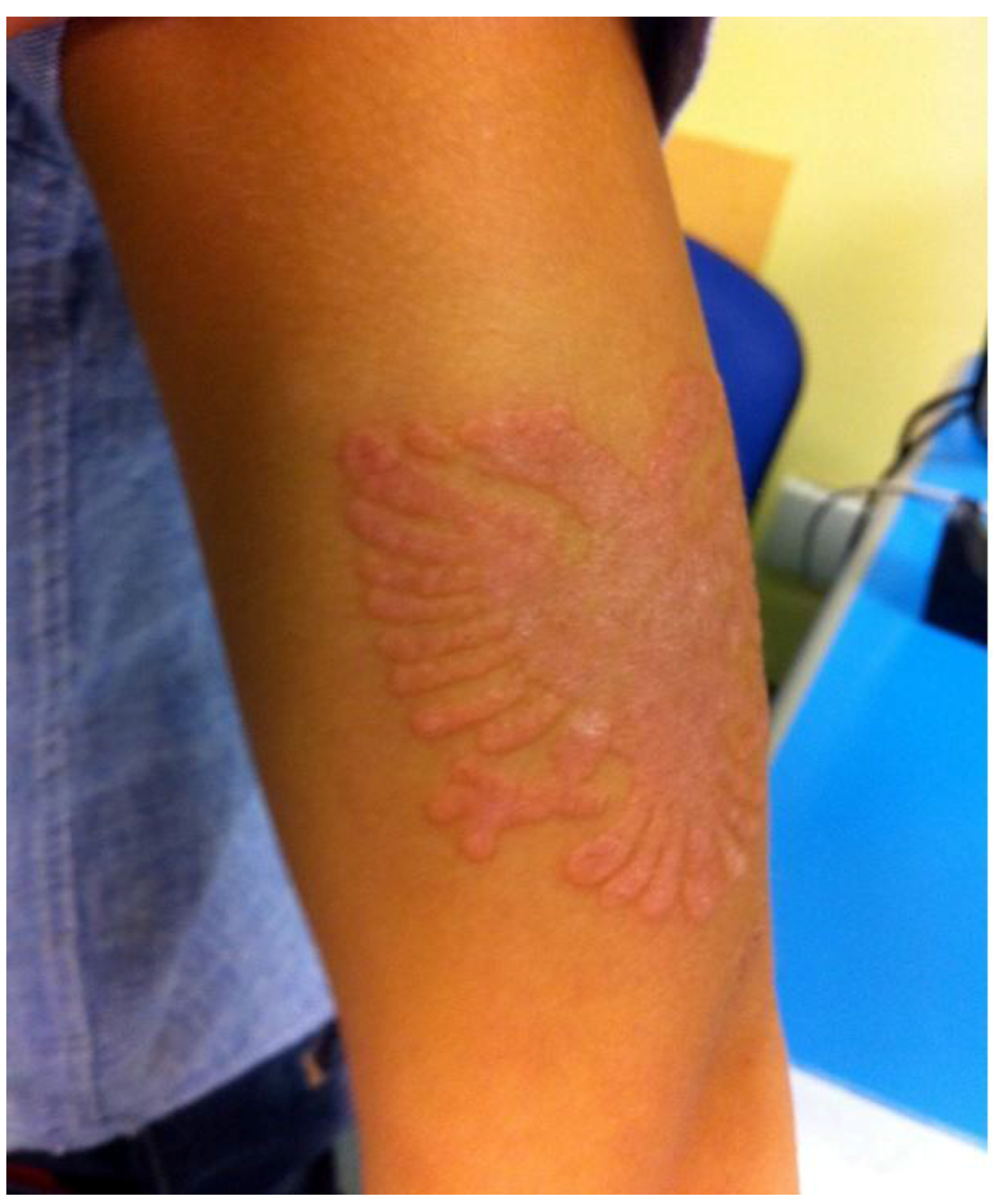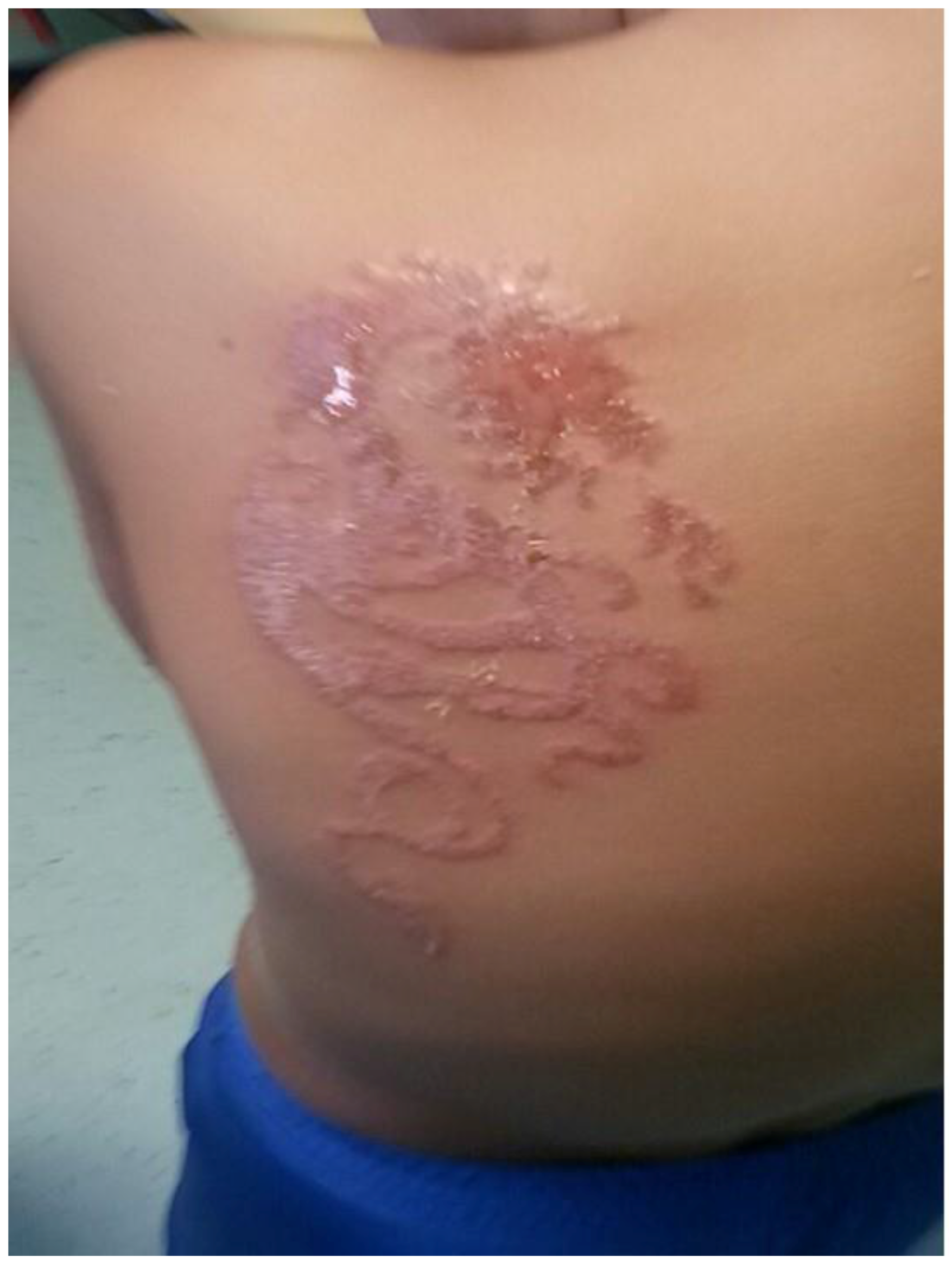Temporary Black Henna Tattoos and Sensitization to para-Phenylenediamine (PPD): Two Paediatric Case Reports and a Review of the Literature
Abstract
:1. Background
2. Case Presentation
3. Discussion
4. Conclusions
Acknowledgments
Author Contributions
Conflicts of Interest
Funding
Ethics, Approval and Consent to Participate
References
- Diepgen, T.L.; Naldi, L.; Bruze, M.; Cazzaniga, S.; Schuttelaar, M.L.; Elsner, P.; Goncalo, M.; Ofenloch, R.; Svensson, Å. Prevalence of contact allergy to p-phenylenediamine in the European general population. J. Investig. Dermatol. 2016, 136, 409–415. [Google Scholar] [CrossRef] [PubMed]
- Pasricha, J.S.; Gupta, R.; Panjwani, S. Contact dermatitis to henna (Lawsonia). Contact Dermat. 1980, 6, 288–289. [Google Scholar] [CrossRef]
- Al-Suwaidi, A.; Ahmed, H. Determination of para-phenylenediamine (PPD) in henna in the United Arab Emirates. Int. J. Environ. Res. Public Health 2010, 7, 1681–1693. [Google Scholar] [CrossRef] [PubMed]
- Goldenberg, A.; Jacob, S.E. Paraphenylenediamine in black henna temporary tattoos: 12-year Food and Drug Administration data on incidence, symptoms, and outcomes. J. Am. Acad. Dermatol. 2015, 72, 724–726. [Google Scholar] [CrossRef] [PubMed]
- Calogiuri, G.; Di Leo, E.; Butani, L.; Pizzimenti, S.; Incorvaia, C.; Macchia, L.; Nettis, E. Hypersensitivity reactions due to black henna tattoos and their components: Are the clinical pictures related to the immune pathomechanism? Clin. Mol. Allergy 2017, 5. [Google Scholar] [CrossRef] [PubMed]
- SCCNFP, 2003. The SCCNFP’s Notes of Guidance for the Testing of Cosmetic Ingredients and Their Safety Evaluation. 5th Revision. Adopted during the 25th Plenary Meeting of 20 October 2003, p. 87. Available online: http://europa.eu.int/comm/health/phrisk/comm (accessed on 7 February 2017).
- Arranz Sánchez, D.M.; Corral De La Calle, M.; Vidaurrazaga Diaz De Arcaya, C.; De Lucas Laguna, R.; Diaz Diaz, R. Riesgos de los tatuajes de henna negra. An. Pediatr. 2005, 63, 448–452. [Google Scholar] [CrossRef]
- Ciriza, B.E.; Galardi, A.M.; Garcia, F.B. Reactions to henna pseudo-tattoos. Allergic sensitisation to paraphenylenediamine. An. Pediatr. 2013, 78, 269–270. [Google Scholar]
- Eager, R.P. Atopy to henna tattoos in children. Eur. J. Emerg. Med. 2005, 12, 189–190. [Google Scholar] [CrossRef] [PubMed]
- Kluger, N.; Raison-Peyron, N.; Guillot, B. Temporary henna tattoos: Sometimes serious side effects. Presse Med. 2008, 37, 1138–1142. [Google Scholar] [CrossRef] [PubMed]
- Belton, A.L.; Chira, T. Fatal anaphylactic reaction to hair dye. Am. J. Forensic Med. Pathol. 1997, 18, 290–292. [Google Scholar] [CrossRef] [PubMed]
- Soni, S.S.; Nagarik, A.P.; Dinaker, M.; Adikey, G.K.; Raman, A. Systemic toxicity of paraphenylenediamine. Indian J. Med. Sci. 2009, 63, 164–166. [Google Scholar] [PubMed]
- Ortiz, S.J.M.; Esteve, M.A.; Subiabre, F.D.; Victoria, M.A.M.; de la Cuadra, O.J.; Zaragoza, N.V. Para-phenylenediamine allergic contact dermatitis due to henna tattoos in a child and adolescent population. An. Pediatr. 2017, 86, 122–126. [Google Scholar]
- Spornraft-Ragaller, P.; K¨ammerer, E.; Gillitzer, C.; Schmitt, J. Severe allergic reactions to para-phenylenediamine in children and adolescents: Should the patch test concentration of PPD be changed? J. Dtsch. Dermatol. Ges. 2012, 10, 258–263. [Google Scholar] [CrossRef] [PubMed]
- Onder, M.; Atahan, C.A.; Oztas, P.; Oztas, M.O. Temporary henna tattoo reactions in children. Int. J. Dermatol. 2001, 40, 577–579. [Google Scholar] [CrossRef] [PubMed]
- Borrego, L.; Hernandez-Machin, B.; Gonzalez, O.; Hernández, B. Sensitization to para-phenylenediamine in a streetside temporary tattoo artisan. Contact Dermat. 2005, 52, 288–289. [Google Scholar] [CrossRef] [PubMed]
- Rogers, C.; King, D.; Chadha, L.; Kothandapani, J.S. ‘Black Henna Tattoo’: Art or allergen? BMJ Case Rep. 2016. [Google Scholar] [CrossRef] [PubMed]
- Brancaccio, R.R.; Brown, L.H.; Chang, Y.T.; Fogelman, J.P.; Mafong, E.A.; Cohen, D.E. Identification and quantification of para-phenylenediamine in a temporary black henna tattoo. Am. J. Contact Dermat. 2002, 13, 15–18. [Google Scholar] [CrossRef] [PubMed]
- Wang, P.G.; Krynitsky, A.J. Rapid determination of para-phenylenediamine by gas chromatography–mass spectrometry with selected ion monitoring in henna-containing cosmetic products. J. Chromatogr. B 2011, 879, 1795–1801. [Google Scholar] [CrossRef] [PubMed]
- Di Prisco, M.C.; Puig, L.; Alomar, A. Contact dermatitis due to paraphenylenediamine (PPD) on a temporal tattoo with henna. Cross reaction to azoic dyes. Investig. Clin. 2006, 47, 295–299. [Google Scholar]
- Nikkels, A.; Henry, F.; Pierard, G. Allergic reactions to decorative skin paintings. J. Eur. Acad. Dermatol. Venereol. 2000, 15, 140–142. [Google Scholar] [CrossRef]
- Simpson-Dent, S.L.; Hunt, S.H.; Davison, S.C.; Wakelin, S.H. Tattoo dermatitis from primary sensitization to clothing dyes. Contact Dermat. 2001, 45, 248. [Google Scholar] [CrossRef]
- Wolf, R.; Wolf, D.; Matz, H.; Orion, E. Cutaneous reactions to temporary tattoos. Dermatol. Online J. 2003, 9, 3. [Google Scholar] [PubMed]
- Arroyo, M. Black henna tattoo reaction in a person with sulfonamide and benzocaine drug allergies. J. Am. Acad. Dermatol. 2003, 48, 301–302. [Google Scholar] [CrossRef] [PubMed]
- Jung, P.; Sesztak-Greinecker, G.; Wantke, F.; Götz, M.; Jarisch, R.; Hemmer, W. A painful experience: Black henna tattoo causing severe, bullous contact dermatitis. Contact Dermat. 2006, 54, 219–220. [Google Scholar] [CrossRef] [PubMed]
- Chung, W.H.; Chang, Y.C.; Yang, L.J.; Hung, S.I.; Wong, W.R.; Lin, J.Y.; Chan, H.L. Clinicopathologic features of skin reactions to temporary tattoos and analysis of possible causes. Arch. Dermatol. 2002, 138, 88–92. [Google Scholar] [CrossRef] [PubMed]
- Tan, E.; Garioch, J. Black henna tattoos: Coexisting rubber and para-phenylenediamine allergy? Clin. Exp. Dermatol. 2007, 32, 782–783. [Google Scholar] [CrossRef] [PubMed]
- Matulich, J.; Sullivan, J. A temporary henna tattoo causing hair and clothing dye allergy. Contact Dermat. 2005, 53, 33–36. [Google Scholar] [CrossRef] [PubMed]
- Leggiadro, R.J.; Boscamp, J.R.; Sapadin, A.N. Temporary tattoo dermatitis. J. Pediatr. 2003, 142, 586. [Google Scholar] [CrossRef] [PubMed]
- Mohamed, M.; Nixon, R. Severe allergic contact dermatitis induced by paraphenylenediamine in paint-on temporary ‘tattoos’. Australas. J. Dermatol. 2000, 41, 168–171. [Google Scholar] [CrossRef] [PubMed]
- Kaatz, M.; Elsner, P.; Bauer, A. Body-modifying concepts and dermatologic problems: Tattooing and piercing. Clin. Dermatol. 2008, 26, 35–44. [Google Scholar] [CrossRef] [PubMed]
- Neri, I.; Guareschi, E.; Savoia, F.; Patrizi, A. Childhood allergic contact dermatitis from henna tattoo. Pediatr. Dermatol. 2002, 19, 503–505. [Google Scholar] [CrossRef] [PubMed]
- Gulen, F.; Zeyrek, D.; Altinoz, S.; Peker, E.; Demir, E.; Tanac, R. Urticaria and angioneurotic edema due to the temporary henna tattoo. Minerva Pediatr. 2006, 58, 583–585. [Google Scholar] [PubMed]
- Di Landro, A.; Valsecchi, R.; Marchesi, L. Allergic reaction with persistenthypopigmentation due to temporary tattoing with henna in a baby. Contact Dermat. 2005, 52, 338–339. [Google Scholar] [CrossRef] [PubMed]
- Spornraft-Ragaller, P.; Schuch, A.; Uter, W. Extreme patch test reactivity to p-phenylenediamine but not to other allergens in children. Contact Dermat. 2011, 65, 220–226. [Google Scholar] [CrossRef] [PubMed]
- Ho, S.G.; White, I.R.; Rycroft, R.J.; McFadden, J.P. A new approach to patch testing patients with para-phenylenediamine allergy secondary to temporary black henna tattoos. Contact Dermat. 2004, 51, 213–214. [Google Scholar] [CrossRef] [PubMed]
- Akhras, V.; Ostlere, L. Is patch testing for PPD routinely necessary in patients with reactions to henna tattoos? Contact Dermat. 2005, 53, 238. [Google Scholar] [CrossRef] [PubMed]
- Almeida, P.J.; Borrego, L.; Pulido-Melian, E.; Gonzalez-Diaz, O. Quantification of p-phenylenediamine and 2-hydroxy-1,4-naphthoquinone in henna tattoos. Contact Dermat. 2011, 66, 33–37. [Google Scholar] [CrossRef] [PubMed]
- Jacob, S.E.; Brod, B.A. Paraphenylenediamine in black henna tattoos. J. Clin. Aesthet. Dermatol. 2011, 4, 46–47. [Google Scholar] [PubMed]


© 2017 by the authors. Licensee MDPI, Basel, Switzerland. This article is an open access article distributed under the terms and conditions of the Creative Commons Attribution (CC BY) license (http://creativecommons.org/licenses/by/4.0/).
Share and Cite
Panfili, E.; Esposito, S.; Di Cara, G. Temporary Black Henna Tattoos and Sensitization to para-Phenylenediamine (PPD): Two Paediatric Case Reports and a Review of the Literature. Int. J. Environ. Res. Public Health 2017, 14, 421. https://doi.org/10.3390/ijerph14040421
Panfili E, Esposito S, Di Cara G. Temporary Black Henna Tattoos and Sensitization to para-Phenylenediamine (PPD): Two Paediatric Case Reports and a Review of the Literature. International Journal of Environmental Research and Public Health. 2017; 14(4):421. https://doi.org/10.3390/ijerph14040421
Chicago/Turabian StylePanfili, Elisa, Susanna Esposito, and Giuseppe Di Cara. 2017. "Temporary Black Henna Tattoos and Sensitization to para-Phenylenediamine (PPD): Two Paediatric Case Reports and a Review of the Literature" International Journal of Environmental Research and Public Health 14, no. 4: 421. https://doi.org/10.3390/ijerph14040421






